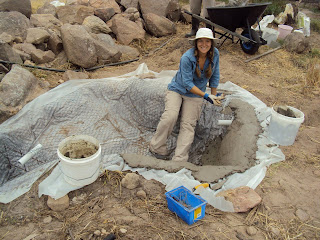I stayed at
Namo Buddha Resort, Nepal, for 5 months in 2010-2011 after completing the Permaculture Design Course at a nearby farm, HASERA. Namo Buddha Resort is approximately 45 km SE of Kathmandu.
My arrangement was to work for the farm half time to help them develop their organic farm, and for the rest of the time be free to study permaculture in other ways, on my own. My time at the farm was a great opportunity to experience the negotiation of working with landowners to come up with a design, working in a foreign context and building my technical skills for mapping and permaculture theory.
Unlike the common situation in industrialized countries, the Nepali government keeps no substantial arial photos, or property maps. Property boundaries are mostly undocumented although well remembered by neighbors. So, my first task was to begin mapping the incredibly complex mountain environment. With a measuring tape, viewing compass and my computer I began making accurate to-scale maps of the property. Satellite photos are useful at a larger scale, but the other tools are necessary for the small gardens that exist on the property. The outer property boundaries are mostly held in memory, which meant numerous sessions of questions and discussions with the current owners and long term employees.
Here are some samples,
 |
| Background satelite photo property of Google Maps. |
The gardens exist on terraces, which is what gives the curvy shapes. The maps are made using vector drawing software, and it is easy to export different versions with varying amounts of features or gridlines. Calculating area of an irregular shape is easy on the computer and is something I used to help predict yield from the farm. I find maps very useful to draw on and re-imagine a property as well as keep records on regular operations.
After coming to a satisfactory point with the mapping, and giving the gardens names based on their compass points, I began to create a crop plan for the largest garden. I used mostly recommendations and data from books and papers by John Jeavons although I referred often to my previous study of Elliot Coleman's writings and what I learned during the program I completed at Everdale Environmental Learning Center, Canada.
The North West Garden is the largest so I will show it as an example. Here is the garden,
The note about "modified bed borders" is because I proposed to adjust the borders a little bit to make all the beds have the same area. Having beds of the same area makes the crop plan simpler.
I began by assessing the garden for the sun that falls on it, just by sketching the shadow at key times of the day. The western section of the garden is very shady, so I left it as a composting or mushroom area and did not include it in the crop plan.
The crop plan was made on a spreadsheet and exported to PDF to share,
The operation has existed for many years, and gone through many phases of development. Designers, architects, managers and artists have come and gone, contributing their own work to the project before moving on. When I arrived the owners explained that they were looking for an unobtrusive design. Although some well known designers such as Sepp Holzer had visited the farm and made their own recommendations, the owners rejected the idea of using large machinery for heavy landscaping. No doubt the owners of this resort and farm have their work cut out for them for many years to come, and it was a pleasure to make a contribution to the project.















